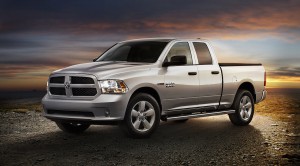
The new 2015 Ram 1500 Express equipped with the maker’s EcoDiesel delivers an impressive 29 miles per gallon on the highway.
It wasn’t all that long ago when light duty pickup buyers would have celebrated seeing fuel economy numbers approaching the high teens. Now, however, that’s something even heavy-duty models often deliver.
But can manufacturers crack the mileage ceiling with a truck that would get 30 mpg or better? Several makers are coming tantalizingly close.
There’s been “a lot of noise around” fuel economy in the light truck segment, FCA CEO Sergio Marchionne said during an appearance at the Detroit Auto Show. Indeed, his own company has been crowing loudly about an updated version of its own full-size model, the new 2015 Ram 1500 Express.
Equipped with the maker’s EcoDiesel, it will deliver an impressive 29 miles per gallon on the highway. That’s a one mpg boost from the current Ram 1500 EcoDiesel model, and stands as the “highest fuel economy among all pickups in the industry,” proclaims Ram boss Bob Hegbloom.
There had been some speculation that Ford would trump the Ram line when it finally announced fuel economy figures for its all-new, aluminum-bodied F-150 truck. By eliminating as much as 700 pounds, the maker was automatically giving mileage a boost, and it gained even more efficiency with the new, 2.7-liter version of its turbocharged EcoBoost V-6.
But Ford chose to balance efficiency and capabilities, and, in the end, was only about to nudge the highway numbers up to a max 26 mpg on the 2015 F-150, and that with a rear-drive version of the big truck.
That is, nonetheless, “a significant achievement,” asserts Ford’s global product development director Raj Nair, noting it’s an all-time best for a gasoline-powered full-sized pickup. In fact, it’s only 1 mpg short of the highway mileage of the new midsize Chevrolet Colorado truck.
That said, manufacturers can’t rest on their laurels. The U.S. Corporate Average Fuel Economy, or CAFE, standard, jumps to 35.5 mpg in 2016 (with cars required to average 39 mpg, trucks 30 mpg). There’s an even tougher target to come, an overall 54.5 mpg number going into effect in 2025. So, while big trucks won’t have to stretch as far as subcompact sedans, they’ve got a long way to go.
To get there, truck makers are looking at a number of options, ranging from the use of aluminum and other lightweight materials – such as carbon fiber – to advanced powertrain systems. Expect to see most pickups equipped with 8, 9, even 10-speed gearboxes by decade’s end, industry analysts say.
(Ram rebels against roads more travelled. For more, Click Here.)
And a growing number of those big trucks could switch to more advanced and alternative power sources, whether turbocharged, diesel or even hybrid.
The spotlight in the months ahead could fall on Nissan, which last week revealed an all-new version of its Titan pickup. There will be a standard light-duty model and a new XD edition, which targets a sort of medium-duty segment. Notably, the Japanese maker’s Detroit Auto Show press conference focused on the new diesel that will be offered in the 2016 Titan line. Whether it will allow Nissan to be the first maker to punch a pickup through the 30 mpg barrier will be revealed closer to the new truck’s launch.
(Click Here for details about Ford’s future use of aluminum in vehicles.)
Pickup buyers are a tough bunch to please. They routinely abuse their trucks and are demanding when it comes to towing and cargo capacity. But fuel economy has also become a major factor in choosing a new model, according to industry surveys.
Mileage alone isn’t the complete equation, however. “For our customers, fuel efficiency is measured at the wallet,” contends Ford product czar Nair. And the calculation is more about the complete cost of ownership, which includes any up front premium for a more fuel-efficient powertrain.
(To see why Toyota is staying the course with improved fuel economy, Click Here.)
An EcoDiesel package adds about $2,850 over the price of Ram’s 5.7-liter Hemi V8, while the 2.7-liter EcoBoost in the F-150 adds $495 to the MSRP. Then there’s the price of diesel fuel, a U.S. average $2.905 a gallon, according to the AAA’s Daily Fuel Gauge Report, compared to $2.061 for regular unleaded. That gap alone makes a diesel model a much tougher sell.
For now, the plunge in fuel prices has kicked the pickup truck segment into high gear, sales surging to their levels not seen since before the Great Recession. Few analysts expect gas to stay cheap for any extended period, however. Whether truck sales would survive an equally rapid run-up in fuel costs could depend on how well manufacturers can improve their mileage.
